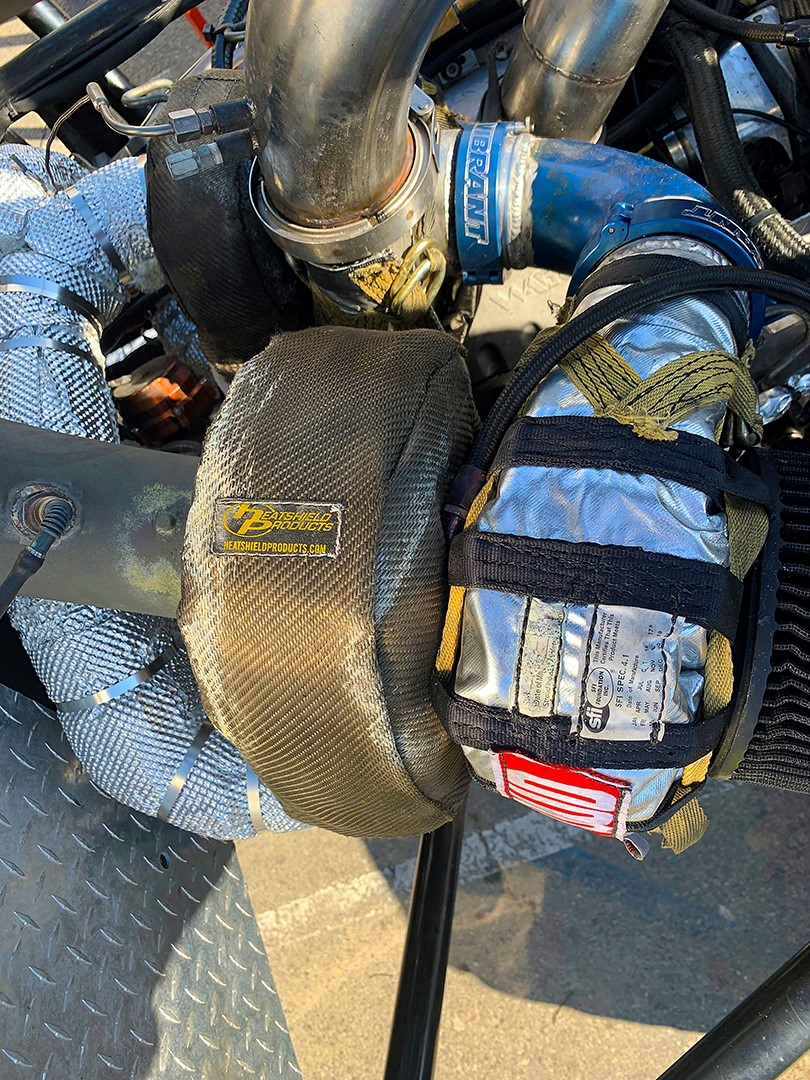Exhaust Gas Temperature, Turbos, Turbo Shields, and Making Power
You’ll see us talking up using Heatshield Products exhaust wrap and/or insulation to keep more heat in your exhaust system for multiple reasons. First, using an automotive heat shield product helps to cut down your exhaust gas temperature, which can increase underhood temperatures and interior heat. Second, keeping more heat in the exhaust system helps increase performance, especially in turbocharged applications. You may be wondering, how does it increase turbo performance?
What Is Exhaust Gas Temperature (EGT)?
With a gas or diesel engine, exhaust gas temperature (EGT) has a direct correlation to engine performance and health. Understanding EGT can be an important tuning tool (especially for turbo power applications), and it can help you understand how to best wrap your headers and exhaust with an effective thermal barrier. EGT directly relates to exhaust gas velocity, in that as the exhaust temperature rises, the moves at a higher velocity. With an internal combustion engine (gas or diesel), the EGT will rise as the engine makes more power or as the air/fuel mixture leans out. In the case of a lean condition within the engine, an EGT that is too high can lead to major detonation and cause severe engine damage. Back in the 1970s and the era of carburetion and tightening emissions standards, the factory would tune engines to run as lean as possible. This meant they tuned catalytic converters to heat up faster so that they could quickly perform their intended purpose and also burn up as much as possible in the combustion chamber. This process, manufacturers believed, reduced the number of fluorocarbons and other pollutants left over from the combustion process.
What does a safe higher EGT (meaning the air/fuel ratio is within optimal parameters) mean in a normally aspirated engine when it comes to better performance? As the exhaust temperature climbs and raises gas velocity for each cylinder, exhaust gas scavenging increases. More spent gases get sucked out of the combustion chamber while the exhaust valve is open. The more spent gasses that can be removed before the exhaust valve closes, the better the next combustion cycle will be as a fresh fuel/air charge is brought into the cylinder.
With a turbocharged engine, increased EGT helps on multiple fronts. The first is the same as with the naturally aspirated engine: getting all the gasses out of the combustion chamber will help with a better burn when combustion takes place. Second, with increased EGT, the turbocharger spools up to create boost much faster and also cuts down on turbo lag. This is from the increased velocity of the exhaust gasses, thanks to the higher EGT. The third benefit of higher exhaust temperature is that with increased exhaust gas velocity, the turbo can spool higher and create more boost, leading to an increase in horsepower once the wastegate and blow-off valve are tuned accordingly for the increased boost.
It’s easy to keep more heat in the exhaust system to help boost the EGT. Ridiculously easy, actually! Start with the turbo itself. A proper turbo heat shield on the exhaust side will help insulate the turbo housing and keep more heat in boosting the EGT. There’s also the added benefit of cutting down on the amount of exhaust temperature the turbo radiates under the hood and causes negative effects. There are multiple options from Heatshield Products when it comes to turbocharger heat shields, including a DIY turbo shield kit for odd-sized/shaped turbochargers.

How Adding a Heat Shield Helps Exhaust Temperature
Adding a turbo heat sheet like the Lava Turbo Shield pictured above helps keep significantly more heat inside the turbo housing to increase EGT and exhaust gas velocity. This decreases the time it takes the turbo to spool up and start making boost and reduces the amount of heat the turbo radiates under the hood or under the vehicle (if the turbo is remote-mounted).
This particular Lava Turbo Shield is mounted on Heavy D’s BroDozer monster truck. A true testament to Lava Turbo Shield’s ruggedness, this one has survived some serious beatings and looks pretty good for something that has been installed since June of 2018. It is constantly exposed to elements like dirt, mud, and heat, including an engine fire at one point! Adding an exhaust wrap or exhaust insulation like Heatshield Armor to the feed and downpipe (on remote-mounted turbos) helps to shield the turbo from exhaust temperatures and to keep the EGT up, which helps sustain increased exhaust gas velocity longer for better performance and turbo consistency.

